If you buy through our links, we may earn an affiliate commission. This supports our mission to get more people active and outside.Learn about Outside Online's affiliate link policy
Super Shoe Showdown 2025: The Best Racers Head-to-Head in the Lab and on Testers’ Feet
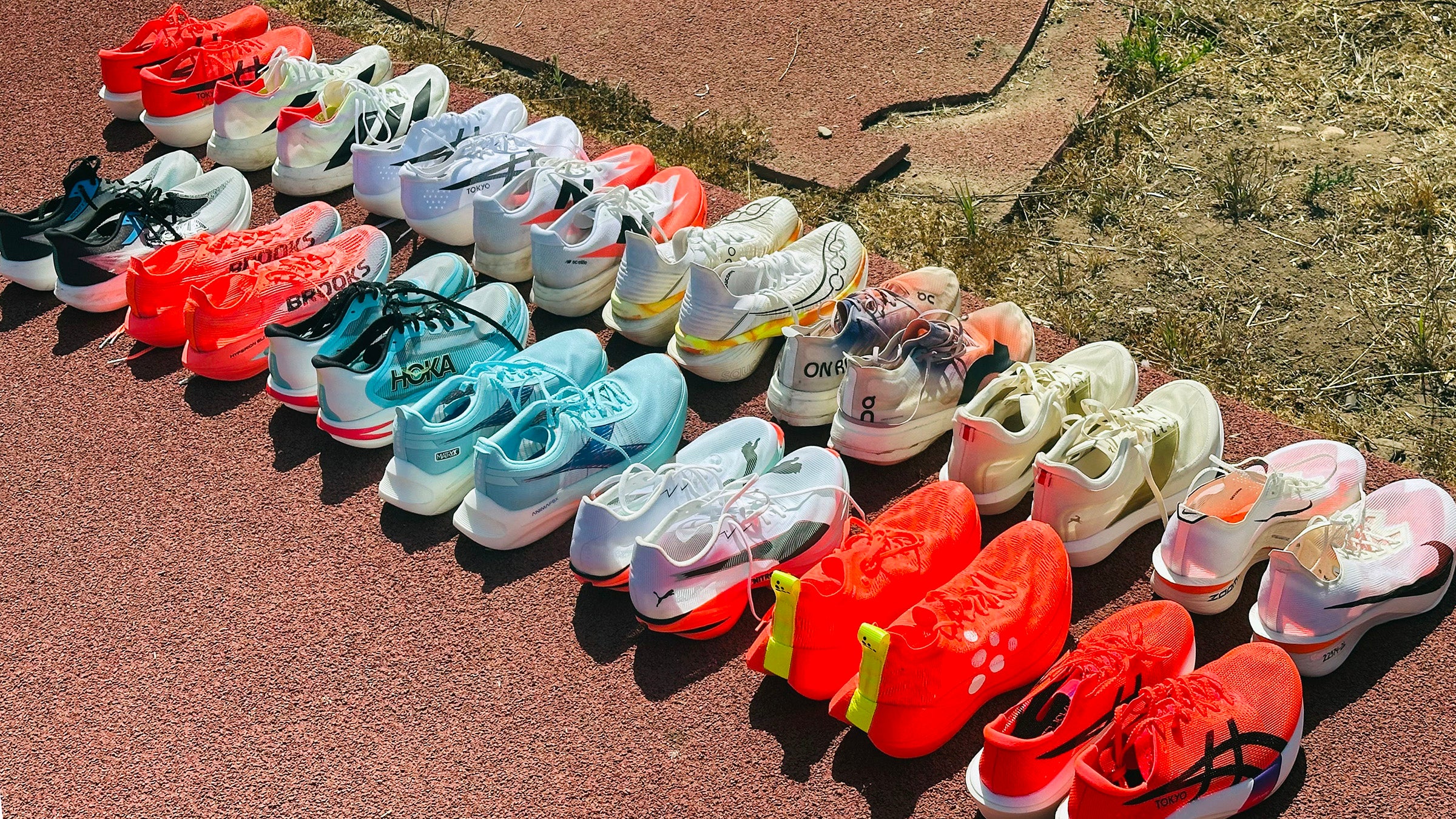
(Photo: 101 Degrees West)
Table of Contents
Eight years after the debut of the first super shoe, the bouncy racers are no longer new nor controversial, but they continue to amaze with their ability to enliven a run and produce fast times. Every shoe in this category boasts some sort of ultralight, hyper-responsive foam with an embedded, curved, carbon-fiber plate—but each delivers a surprisingly unique ride.
Designers manipulate a myriad of elements—midsole material and thickness, rocker location and slope, plate stiffness and shape—to fine-tune the shoe’s roll and rebound. Each of the best super shoes we tested is optimized for a specific stride pattern, so it’s essential to find the one that complements how you move.
This showdown provides guidance on the general characteristics of each shoe and an idea of which super shoes cater to which type of running stride and ride preferences—but the only sure way to find the super shoe that makes you fly is to try some on and take them for a spin.
September 2025 Update: We tested and reviewed 15 new super shoes in the field and the lab and carried over four models from last year that are still available and competitive.
Similar Reads
How We Tested the Best Super Shoes
Four editors and lead testers ran in each super shoe over the course of several months and in a final, back-to-back showdown. Each tester evaluated each super shoe’s fit, cushioning, ride, and how well it complemented their stride. The Outside Lab then measured the force required to compress each midsole to determine a “soft score”—ranging from one ( firmest) to 10 (squishiest). The lab also located the initial tipping point of the forefoot rocker along the length of each shoe.
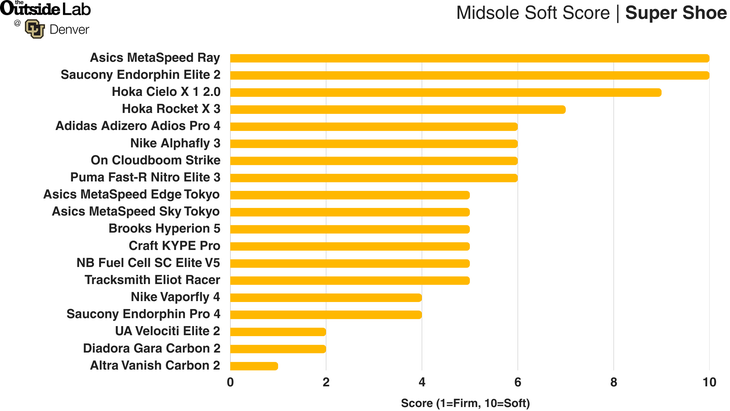

See our full testing methodology after the reviews
Our Favorite Super Shoes, At a Glance
Marathon
Nike Alphafly 3: Three of our four testers named this as a top pick, two for the marathon and one for the half marathon, citing its superior combination of soft cushioning and trampoline-like bounce.
Also called out as best super shoes for a marathon: Adidas Adizero Adios Pro 4, Asics Metaspeed Edge Tokyo, New Balance Fuel Cell SC Elite V5, On Cloudboom Strike, Saucony Endorphin Pro 4
5K to Half Marathon
Puma Fast-R Nitro Elite 3: Half the testers named this as first choice for short- to medium-length races given its unmatched propulsive push-off and light weight.
Nike Vaporfly 4: Half the testers would choose this super shoe for shorter races because of its firmer, stable stance and quick, peppy rebound.
Also called out as top choices for sub-marathon races: Asics Metaspeed Sky Tokyo, Nike Alphafly 3
Mile to 5K
Asics Metaspeed Ray: Three out of four testers would choose to lace up this shoe for short races up to 5K because of its ultralight weight and explosive rebound.
Also named as a top choice for short races: UA Velociti Elite 2
Every Super Shoe We Tested
- Adidas Adizero Adios Pro 4 ($250)
- Altra Vanish Carbon 2 ($240)
- Asics MetaSpeed Edge Tokyo ($270)
- Asics MetaSpeed Ray ($300)
- Asics MetaSpeed Sky Tokyo ($270)
- Brooks Hyperion 5 ($275)
- Craft KYPE Pro ($320)
- Diadora Gara Carbon 2 ($300)
- Hoka Cielo X 1 2.0 ($275)
- Hoka Rocket X 3 ($250)
- NB Fuel Cell SC Elite V5 ($265)
- Nike Alphafly 3 ($295)
- Nike Vaporfly 4 ($270)
- On Cloudboom Strike ($280)
- Puma Fast-R Nitro Elite 3 ($300)
- Saucony Endorphin Elite 2 ($290)
- Saucony Endorphin Pro 4 ($240)
- Tracksmith Eliot Racer ($280)
- UA Velociti Elite 2 ($250)
Adidas Adizero Adios Pro 4
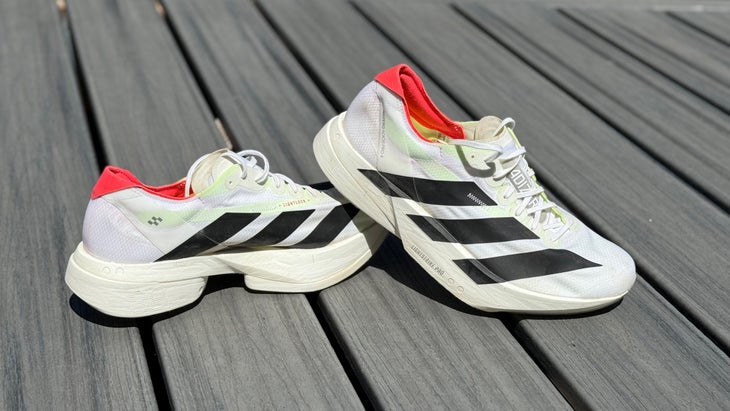
Weight: 7.1 oz (men’s); 6.4 (women’s)
Stack Heights: 39-33 mm / 6 mm drop
Lab Soft Score: 6 Perceived Soft Score: 8
Rocker: Average location (59%) Feels: Starts gradually then drops off steeply
At a Glance: Updated with new, softer foam, the Adios Pro 4 delivers a smooth, moderately stable ride with a well-timed bouncy rebound that complements efficient, mid-to-forefoot strikers.
Tech Details
- Uses a new, softer Lightstrike Pro foam compound that delivers a plush, springy—but less stable—ride
- Lighter than the Pro 3 by nearly an ounce makes it now about average in weight among super shoes
- Soft, light, breathable woven mesh, upper, with padded tongue
- Secure lockdown via internal midfoot support band
- Fit is slightly narrower at the forefoot
- New outsole compound is soft and claims to be durable
Cory
Ride Rating: Standout
Bravo, Adidas. You nailed the latest update to the Adios Pro 4, bringing it on par with the top supershoes. The softness underfoot is just about perfect—cushioned, but not too soft, yet springy and really fast. I ran the 2025 Boston Marathon in the Pro 4 and it performed flawlessly. I would have no problem lacing these up for races all the way down to 5k.
Lisa
Ride Rating: Standout
This shoe feels like it gives me some pop, the Lightstrike Pro foam makes me feel fast and energetic, even when I’m not. The shoe has a lightweight feel on the foot, but one that is soft and comfortable, not too minimal. The rebounding feeling of the Adios Pro 4 makes me love the foam and upper combo. I also really like the look of this shoe.
Abby
Ride Rating: Good
Like its name, I found the Adidas Adizero Adios Pro 4 a bit clunky. The slabs of foam splaying out laterally under the midfoot and behind the heel feel like a lot to wield. The balance also feels a little off for my stride—like it’s too heavy in the midfoot, which makes my turnover feel a little cumbersome. The basic laces put a bow on the unrefined aesthetic. That being said, I found it to be a stable, comfortable, dependable choice for marathon-pace efforts—just not on slick surfaces.
Jonathan
Ride Rating: Good
I was a fan of the firmer Pro 3 with a rolling ride, and was disappointed that Adidas went with a soft, trampoline-bouncy foam in the 4. Still, the ride isn’t entirely squishy: as long as I was keeping up a fast pace the shoe rolled me quickly onto my toes with a powerful push back under the ball, just where and when I needed it. At slower paces, however, the heel felt soft and tippy, and I found it felt awkward to roll from it onto the thick foam under the ball. I wouldn’t want to wear this for a marathon, but maybe a 5K.
Altra Vanish Carbon 2
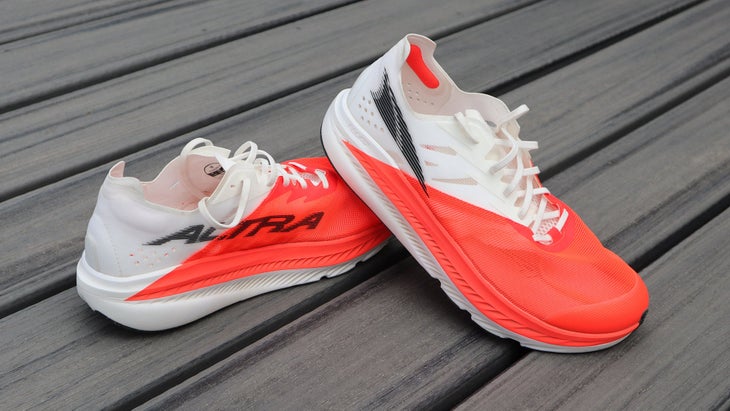
Weight: 8.1 oz (men’s); 5.8 oz (women’s)
Stack Heights: 36–36 mm / 0 mm drop
Lab Soft Score: 1 Perceived Soft Score: 3
Rocker: Average (62%) Feels: Allows stance before smooth, quick roll
At a Glance: Designed for runners seeking the natural feel of a zero-drop sole and a slightly flexible forefoot, this supershoe offers a soft, lively ride if your stride stays quick and forward-balanced.
Tech Details
- Stack height increased from 33mm to 36mm
- 32 percent increase in Altra EGO PRO midsole cushioning for a softer feel underfoot
- A new, full-length carbon fiber plate is 14 percent more asymmetrical (curves inward at the toe), designed to enable a more fluid and natural stride
- Flexibility improved 75 percent by removing the strobel layer, increasing the flexibility of the carbon plate, and using a more elastic midsole compound
Lisa
Ride Rating: Not for Me
Zero-drop shoes encourage a midfoot-landing gait. Since my natural stride is heel-striking, I have to really concentrate in the Vanish Carbon to land midfoot, which increases my cadence and makes me run faster—but uncomfortably. While the cushioning/plate combo of this shoe feels balanced, it’s just not natural to my personal stride.
Jonathan
Ride Rating: Good
As long as I’m moving fast and staying forward-balanced in the Vanish Carbon 2, the ride exhibits the balance the brand is known for: the foam under the ball compresses and the rocker kicks in for a fast, forward roll, while the foot-shaped forefoot lets my toes splay for natural stability. At slower paces, however, with any heel strike at all, the foam squishes so much it feels like my heel is lower than my toes and I have to roll up and over the thick forefoot. I might wear these for a shorter race but not for the marathon where my stride will inevitably deteriorate by the end.
Abby
Ride Rating: Not for Me
Zero-drop shoes simply do not work for me and my history of calf strains. I also found it lacked the pop I’m looking for in a super shoe, and I worry about the stretchy laces preventing a secure lockdown over longer distances. I appreciate the wider toebox, although I need to size up.
Cory
Ride Rating: Good
I’ve typically struggled with Altra’s zero-drop design, finding them too flexible and minimal for my footstrike and preference for a stiffer sole with loads of cushioning. But this model stands out, it softens the traditional zero-drop feel with a subtle toe rocker, soft foam, and a moderately flexible plate that encourages a more forward-leaning stance. It’s the first Altra that truly works for me and serves as a great entry point for zero-drop shoes.
Asics MetaSpeed Edge Tokyo
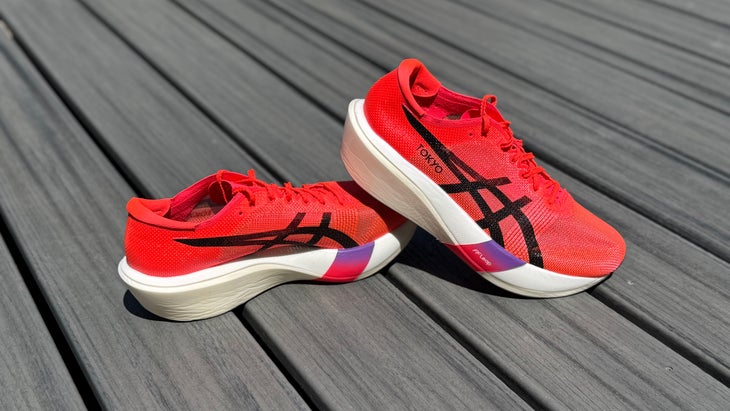
Weight: 5.9 oz (unisex)
Stack Heights: 39.5-34.5 mm / 5 mm drop
Lab Soft Score: 5 Perceived Soft Score: 5
Rocker: Late (69%) Feels: Lots of springy foam under ball, falls away quickly under toes
At a Glance: Engineered for what Asics calls cadence-driven runners, the all new Edge Tokyo uses a new, smoothly bouncy foam and late, steep rocker to create a ride that propels runners who increase their stride rate as they speed up.
Tech Details
- A new FF LEAP foam, made from softer, bouncier A-TPU, is layered over slightly more stable FF Turbo+ . Asics claims the Edge Tokyo is ~21% more energy efficient than Edge Paris.
- The plate is lower and has a steeper forefoot rocker than the previous model, enhancing forward propulsion and turnover for quick-striding runners
- Roughly a half an ounce lighter than Edge Paris, making it lighter than most super shoes
- New upper and a refined last create better lockdown, breathability, and lighter overall feel
Jonathan
Ride Rating: Standout
The Edge provides a responsive, supportive platform from heel to forefoot and a stable, springy stance on the thick stack of foam under the ball, before the late, steep rocker speeds me forward with a well-timed boost. My stride feels efficient in these shoes, turning over quickly rather than bouncily bounding down the road, and there’s more ground connection than in most super shoes, yet I’m amply cushioned. This would be my first choice for a marathon.
Abby
Ride Rating: Not for Me
The cliff-like (or should I say, “edge”-like) rocker shape doesn’t work for my stride—it encourages me to heel strike, which my body does not enjoy doing. As a result, running in these was a bit too much of a cerebral and forced experience. The aggressively tapered toebox also means I need to size up.
Cory
Ride Rating: Standout
When Asics first introduced the Metaspeed Sky and Edge I favored the Sky, however since the Paris edition, I’ve come to like the Edge better. The Tokyo series reinforces that even more. The Edge has a much stronger propulsive force than the Sky for me. Once I get to around half-marathon pace the rocker really engages and slingshots me forward. It still holds form down to 3k pace. I don’t think I would wear it for a marathon, but it’s been my go-to for faster track workouts.
Lisa
Ride Rating: Good
While the Sky feels better for my stride than the Edge, I did find myself making an effort to land midfoot in the Edge, which made my half-mile split quicker in this shoe than most others, while feeling similar effort.
Asics Metaspeed Ray
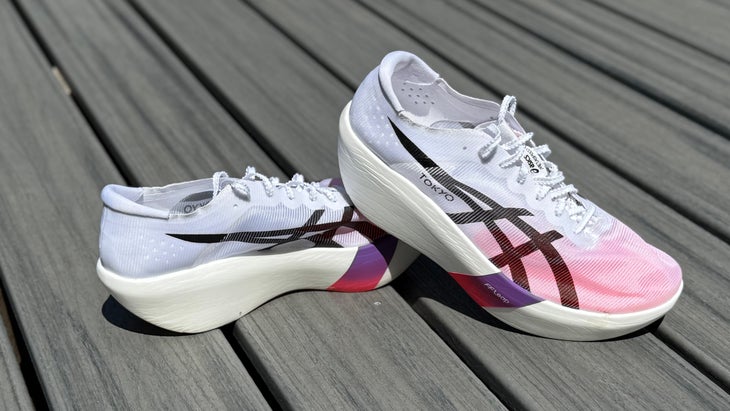
Weight: 4.5 oz (unisex)
Stack Heights: 39.5-34.5 mm / 5 mm drop
Lab Soft Score: 10 Perceived Soft Score: 10
Rocker: Late (67%) Feels: Thick, squishy foam under ball rolls into late, speedy rocker
At a Glance: The lightest carbon fiber supershoe on the market, the Metaspeed Ray is a featherweight, super-soft racer best suited for experienced runners over short to middle distances.
Tech Details
- A new FF LEAP midsole made of A-TPU is Asics’ lightest, softest, and bounciest foam ever.
- Weighing 4.5 ounces for a men’s 9 and women’s 10.5 it is the lightest carbon fiber supershoe on the market
- A three-quarter-length, curved carbon fiber plate starts at the forefoot and ends midfoot
- The ultra-thin, airy Matryx upper provides maximum weight savings and breathability.
Abby
Ride Rating: Standout
I’m ruined. After running in the MetaSpeed Ray, nearly every other shoe feels heavy. But it’s not just the weight that makes it stand out, it’s the revolutionary design—namely the three-quarter-length carbon plate and tapered heel—that complements my forefoot strike and turns this shoe into a rocketship. (Turns out, when you don’t run on your heels, you don’t need anything underneath them.) I wore these for the 7-mile Falmouth Road Race on Cape Cod and felt like I was getting flung down the road—soft and explosive without any mush. Save running on uneven surfaces and going around sharp turns, I found them surprisingly stable at speed.
Lisa
Ride Rating: Standout.
Holy smokes, this shoe is fast. I had, “I’m not worthy!” running through my head while running in the Ray. I felt wobbly in it, especially around tight turns, but when I checked my half-mile split, I was pleasantly surprised at the pace: the shoe made me fly. It also holds my narrow foot well and is comfortable. Plus, it’s insanely light.
Cory
Ride Rating: Standout
This is by far the softest shoe I’ve worn. It feels like running on an energy-filled sponge. During my back-to-back test, I saved the last one for Ray, and sure enough, my last 800m was my fastest. That said, because of how soft it is, it’s a very limited shoe. I would only wear this for short road running from the mile, maybe up to the 10k.
Jonathan
Ride Rating: Not for me
I felt completely disconnected from the ground in this uber-soft shoe and struggled to roll through my stride and time my push-off. I felt like most of my energy was spent balancing, and my stride was forced into a slow-turnover lope waiting for the foam to rebound. It seems this shoe requires a runner with a much longer, powerful stride than mine.
Asics MetaSpeed Sky Tokyo
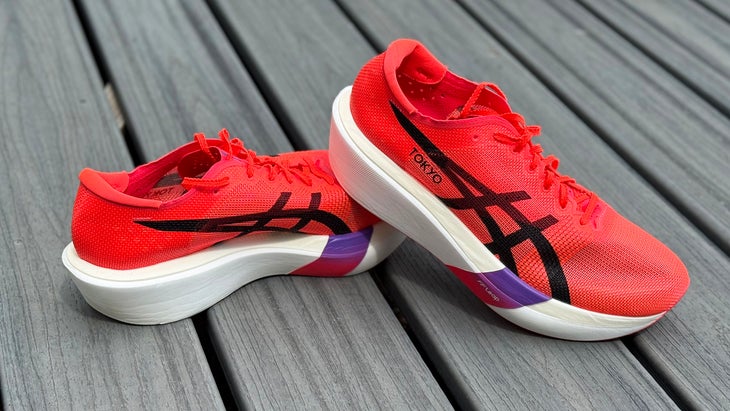
Weight: 5.9 oz (unisex)
Stack Heights: 39.5-34.5 mm / 5 mm drop
Lab Soft Score: 5 Perceived Soft Score: 6
Rocker: Late (69%) Feels: Plate falls away early, letting foot sink and start a long, gradual roll that doesn’t lift the heel until late
At a Glance: Designed for runners who increase their stride length as they speed up, the Sky Tokyo uses a combination of foams to create a stable and bouncy ride, and a flatter carbon plate that is close to the foot to complement runners with long strides that push back powerfully.
Tech Details
- Features Asics’ latest ATPU-based midsole, FF LEAP, beneath a thinner layer of FF Turbo+. Asics claims the new FF Leap foam is 30% softer, 14% more responsive, and 15% lighter than the foam found in Sky Paris
- The plate now sits higher in the midsole, closer to the foot, and has a flatter curvature to encourage more vertical propulsion and a bounce-oriented stride
- A wider base with significant flare works to stabilize the softer midsole
- A new upper offers a lighter, more breathable, and more secure lockdown
Jonathan
Ride Rating: Standout
As advertised, the Sky feels great when striding out: the foam and plate provide a smooth, long transition from heel to toe as my foot sinks into the soft, but not squishy stack, with a well-timed rebound just as I roll off the rocker for a powerful push off. I give it a ride rating of “standout” for races up to the half marathon, but only “good” for longer races, when I’d be more comfortable using a quicker, more efficient stride.
Lisa
Ride Rating: Standout
This shoe just works great with my long, loping stride. The upper also fits my narrow foot well, and I like how quiet the shoe runs compared to louder supershoes. I do feel a tad unstable, as the silhouette of the shoe under the heel—where I land—is narrow.
Cory
Ride Rating: Good
There’s definitely a difference between the ride of the Edge and the Sky because I much prefer the Edge for races up to the half marathon. It’s not that the Sky is a bad shoe, it just doesn’t give me the same forward propulsion the Edge does. The Sky feels more cushioned and doesn’t roll forward as strongly. It’s also very stable, which is why I’d probably go with the Sky over the Edge for the marathon.
Abby
Ride Rating: Good
The MetaSpeed Sky feels like a less poppy, more stable, heavier MetaSpeed Ray. Thanks to the added stability, I would consider switching from the Ray to the Sky for races over a half marathon. But the slightly more tapered toebox rubs on my third through fifth toes, meaning once again I need to size up.
Brooks Hyperion Elite 5
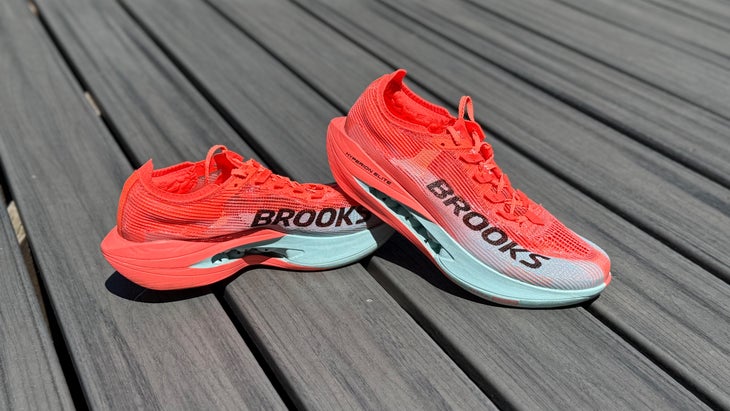
Weight: 6.9 oz (unisex)
Stack Heights: 38-30 mm / 6 mm drop
Lab Soft Score: 5 Perceived Soft Score: 5
Rocker: Early (55%) Feels: Long, moderate, stable roll from ball to toe
At a Glance: With a newly tuned, moderately soft and bouncy foam, the Hyperion 5 excels as a versatile uptempo shoe, pairing enough responsiveness for interval days with a stable, firmer ride that favors runners seeking control and comfort.
Tech Details
- 8% more PEBA-based DNA Gold cushioning in Elite 5 versus the Elite 4 PB
- Full-length Speedvault carbon plate is tuned to different stiffness for different shoe sizes
- Visual midsole bubble cut-outs to reduce weight
- Highly breathable, track-spike inspired TPU-coated yarn upper
Lisa
Ride Rating: Good
This fifth iteration of the Brooks Hyperion Elite is by far the most stable, in my opinion, but still feels narrow and a little tippy under the heel. I like the airy upper, but don’t love the cushioning panels around the heel cup.
Abby
Ride Rating: Good
I don’t dislike anything about this shoe. In fact, there are quite a few things I love about it, namely the padded tongue and heel collar, serrated laces, and bouncy ride. Toeing off felt fluid at marathon pace and jogging pace. But it lacks the zing of the top options on the market.
Jonathan
Ride Rating: Good
Brooks softened the ride of the Hyperion Elite (version 4 was the firmest in last year’s showdown, while this year’s soft score falls in the middle of the pack). Still, the ride feels relatively stable, with a long, moderate rocker, wide forefoot stance, and the foam’s bounce controlled and directed effectively. But I missed the firmly responsive roll of previous versions that were my first choice for long races, while this one started feeling a bit sloppy when I fatigued.
Cory
Ride Rating: Not For Me
Brooks has been trailing in the super shoe game ever since it took off, and it wasn’t until last year that they even introduced a true superfoam. Unfortunately, this one feels like a complete miss for my stride. The ride is firm and more like a low-profile racer than a bouncy super shoe. The ankle collar sits unusually low, right around the ankle bone, making it feel like I’m sitting on the upper rather than in it. My advice? This is a hard pass.
Craft KYPE Pro
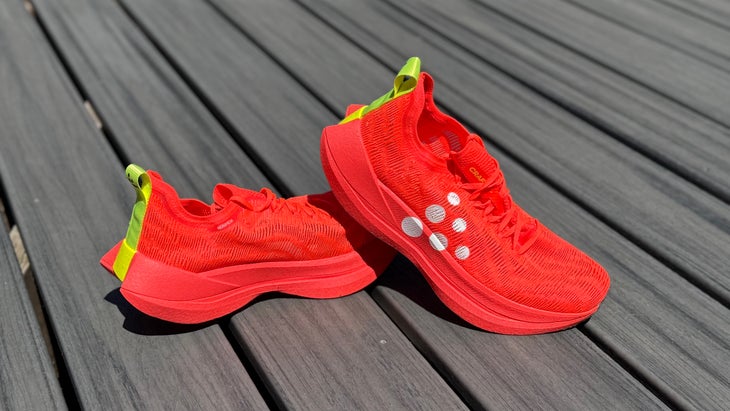
Weight: 7.0 oz (men’s); 6.3 oz (women’s)
Stack Heights: 40-32 mm / 8 mm drop
Lab Soft Score: 5 Perceived Soft Score: 4
Rocker: Average (60%) Feels: Firm foam makes roll steep and aggressive
At a Glance: Made with a firmly tuned PEBA midsole and split heel carbon fiber plate, the KYPE Pro provides runners with a stable platform that forces a quick-rolling stride.
Tech Details
- Features Xx Foam, Craft’s high-rebound, nitrogen-infused PEBA foam with deep center cut-outs
- Embeded ARRIS carbon-fiber plate with split-heel design for stability
- Vittoria-designed Lightsole rubber for enhanced traction
- Open, breathable AeroMesh upper made with 50% recycled polyester
Cory
Ride Rating: Not for me
Firm, prescriptive, and aggressive—that’s how I’d describe the KYPE Pro. And yet, some part of me kind of liked it. Still, when stacked up against every other shoe in this lineup, it just doesn’t compete. The midsole is very firm, and the rocker is extremely aggressive, almost dictating how the shoe wants you to run. For brief moments, I felt in sync with the profile, but trying to stay in that sweet spot over longer distances would be a challenge.
Abby
Ride Rating: Not for Me
This shoe feels peppy at slower paces. But when I crank it down, the plush heel and late-stage rocker make me want to sit on my heels rather than toe off from the forefoot as I naturally do. It’s light and extremely stable and breathable, although I found it slippy in wet conditions. I also found the fully-integrated mesh tongue made it hard to fully lock in the fit.
Lisa
Ride Rating: Not for me
This shoe feels plenty fast, but firm instead of soft, and stiff and ready to charge as opposed to conforming to me. The Kype Pro, more than any other shoe I tested, feels like equipment—like a race car ready to rumble. I’m simply not as comfortable in this shoe, although it’s clearly a speedster.
Jonathan
Ride Rating: Not for me
I expected to like this shoe with its firmer feel and rolling (rather than bouncing) ride. But I felt tentatively balanced high off the ground, and controlled by the aggressive rocker that starts at the heel and sped my stride forward so fast I had trouble timing my push-off. I’m simply not speedy and agile enough for this shoe.
Diadora Gara Carbon 2
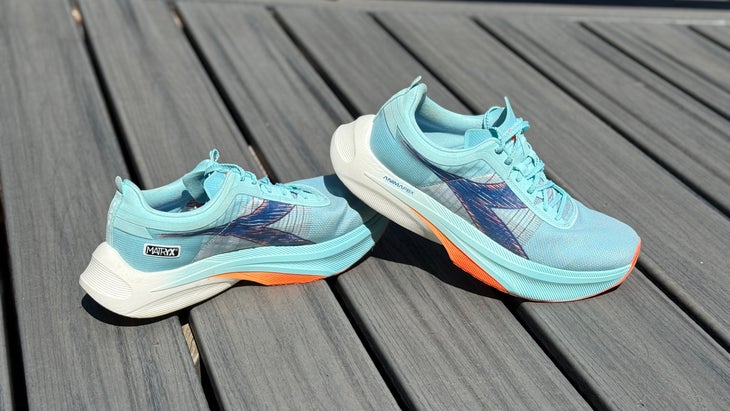
Weight: 8.1 oz (unisex)
Stack Heights: 40-35 mm / 5 mm drop
Lab Soft Score: 2 Perceived Soft Score: 6 (Note: Discrepancy most likely has to do with the difference between the heel, where the plate is close to the foot so the foam measures stiffer, and the soft-feeling forefoot)
Rocker: Early (50%) Feels: Long, gradual, flexible roll with a late up-turn at the toe
At a Glance: A forgiving super shoe crafted with a semi-flexible plate and a wide platform of soft, springy PEBA foam, suitable for a range of runners looking for a stable ride for longer races and uptempo training
Tech Details
- Open-weave Matryx now integrates carbon fibers (vs Kevlar), resulting in a touch less weight and a better hold
- Slightly slimmer forefoot over the original
- Carbon fiber plate that peaks at the heel, dips low at the forefoot, and rises again for a powerful toe-off
- Midsole made of Anima PBX, Diadora’s highest performing PEBA foam
Lisa
Ride Rating: Standout
This shoe surprised me with its pleasant amount of cushioning under the forefoot. I also liked that the wide base provides a stable ride, even around tight corners. And I thought the foam was downright peppy.
Jonathan
Ride Rating: Standout
This shoe gets my vote for the most comfortable and accommodating ride. The heel is wide and the plate high, delivering a stable platform that cushions and rolls me forward to the early, long, gentle rocker with a touch of flexibility. The soft forefoot doesn’t bounce back during my stance and roll but provides a gentle boost under my toes at the end of my push-off. It isn’t the fastest-feeling shoe, but it’s one I’d like to wear for longer workouts and races for its leg-saving ride.
Cory
Ride Rating: Good
For my money, Diadora deserves more attention as they’ve produced several quality shoes lately, including the Gara Carbon 2. Its cushioning and geometry are incredibly accommodating, making it a great option for a wide range of runners. The only reason I hesitate to give it the coveted “Standout” status is that it doesn’t quite deliver that supershoe-level speed. The midsole is cushioned and smooth, but it lacks that awe-inspiring, race-day feel.
Abby
Ride Rating: Not for Me
I wanted to love this shoe because it’s so pretty—Diadora, per usual, nailed the clean yet bold aesthetic. But alas. I have Morton’s toe (a fancy term for my second toe being longer than the first) and the tapered toe box squeezes my second through fifth toes. Meanwhile, there’s a lot of extra volume in the heel for someone who doesn’t heel strike—the foam extends out and back like the train of a dress. Qualms aside, I found the padded heel collar comfortable, the ride peppy but not soft, and it’s exceptionally stable. Plus, it’s uber light for all the bells and whistles.
Hoka Cielo X 1 2.0
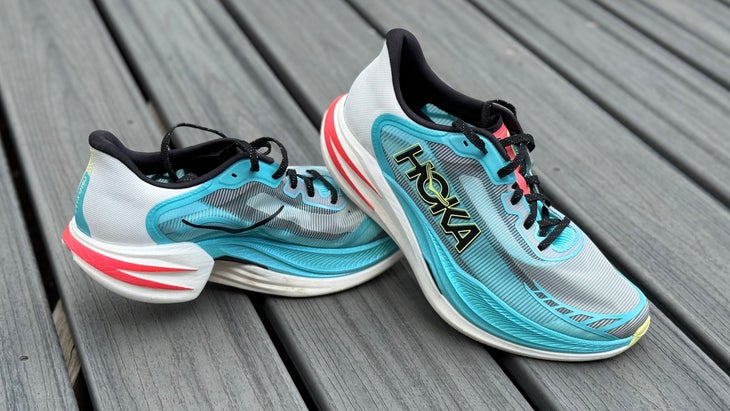
Weight: 7.4 oz (unisex)
Stack Heights: 46-39 mm / 7 mm drop
Lab Soft Score: 9 Perceived Soft Score: 8
Rocker: Early (53%) Feels: Continuous, steep, aggressive roll from heel to forefoot
At a Glance: Designed for the marathon, the extra-tall Hoka Cielo X 1 2.0 has a severe rocker heel-to-toe geometry that fosters a bouncy ride and works best for midfoot landings by stable runners at moderately-fast paces.
Tech Details
- Dual-density PEBA midsole with sculpted cutouts to reduce weight
- Adopts a forked plate that introduces a little heel flex and quicker toe-snap, in place of the stability-oriented winged plate found in v1.
- Steeper rocker and oversized heel-bevel is tuned for an earlier roll and more aggressive forward pitch.
- A more cushioned collar replaces the exposed, firm rim of v1, improving step-in feel without adding bulk.
- Ultra-thin, highly breathable mesh upper with flat laces and a wrap-knit tongue
Jonathan
Ride Rating: Not for me
The Cielo X 1 2.0 has a thicker stack of foam underfoot than any other shoe in the showdown, and it shows: This is a tall, soft, platform with aggressive rockers on both ends that made me feel disconnected, floating along on squishy tires that rolled forward of their own accord and took me along for the ride. Surprisingly, my heart rate said I was efficient while rolling along in these, but my knees and balancing muscles were sore afterwards, and I wouldn’t want to take them out for very far.
Lisa
Ride Rating: Not for me
This shoe just felt bulbous underfoot. The rocker is too pronounced for my liking. The massive amount of foam underneath is insanely cushy, but I felt like this shoe had me rolling in a very awkward pattern. Of the Hoka super shoes, I’m a Rocket X 3 girl.
Abby
Ride Rating: Good
The toe box is too tapered for my foot shape, squeezing my outer toes, which could be rectified by sizing up. I appreciate the softness under the fore- and midfoot and how the rocker propels me forward. I find myself starting to pronate a bit at higher speeds, however, perhaps because of the cutout under the inner midsole.
Cory
Ride Rating: Standout
I’m clearly at odds with my colleagues on this one, but I get where they’re coming from. This shoe has a very distinct ride: The rocker is so pronounced that it forces a midfoot landing, which can feel odd and a bit unstable. What saves it for me, though, is the incredibly bouncy midsole—it’s like running on a pogo stick. Every run feels easier in these. That said, it’s not race-worthy in my book. The unusual rocker sensation and added weight hold it back from that tier. But for everything from daily miles to tempo efforts, this is one of my go-to shoes.
Hoka Rocket X 3
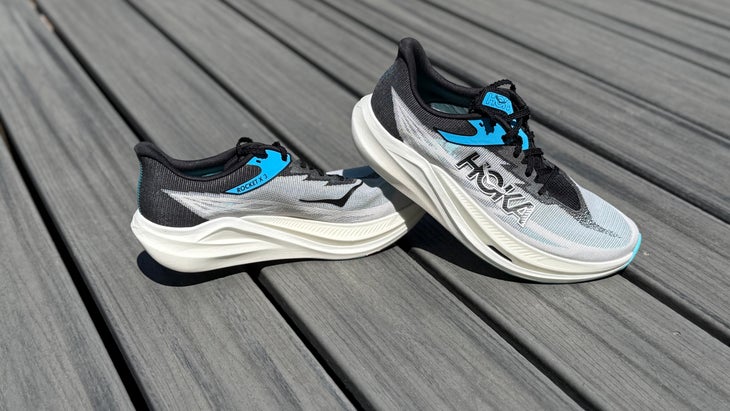
Weight: 7.4 oz (unisex)
Stack Heights: 40-33 mm / 7 mm drop
Lab Soft Score: 7 Perceived Soft Score: 7
Rocker: Early (56%) Feels: Long, very gradual
At a Glance: Two layers of bouncy PEBA foam (softer over firmer) and a split carbon plate with lateral wings deliver a stable and accommodating ride that most testers found best for training.
Tech Details
- Stack increased 4 mm in the heel and 2 mm in the forefoot, raising the heel-toe drop to 7 mm
- The X 3 embeds a softer-tuned PEBA core above a firmer PEBA carrier layer
- The straight plate in the X 2 has been replaced by a split design with lateral “winglets,” designed to add a touch more flex plus better side-to-side stability
- A one-piece warp-knit upper and ungusseted tongue improve breathability and reduce bulk
- A new sticky rubber outsole
Lisa
Ride Rating: Standout.
I appreciate the stable ride of this super shoe. It makes me feel like I’m in control of the shoe, instead of the other way around. I also like how the upper hugs my narrow foot, and the joint-forgiving feeling of the ample foam. This feels like it’s more versatile than just for raceday.
Abby
Ride Rating: Good
As a road racing shoe, the Hoka Rocket X3 is not for me. It feels too heavy, too slow, and (ironically) lacks that x-factor I’m looking for on race day. And yet, I find myself turning to this shoe for uptempo long runs and when I’m running between easy and marathon pace and want a little extra pep in my step. It feels stable over a wide range of paces, and embellishments like the padded heel collar, broad platform, and sticky rubber outsole lend to a comfortable ride over hills and dirt.
Jonathan
Ride Rating: Not for me
I appreciated the comfortable fit and the rearfoot stability of this shoe, but the foam was too soft and the rocker too gradual to complement my stride. I had trouble getting off the ground quickly and felt sluggish, not super.
Cory
Ride Rating: Not for me
I’m honestly a bit at a loss as to where this shoe fits in the Hoka lineup. It’s not a bad shoe by any means, it’s just that the Cielo X1 2.0 feels noticeably bouncier and faster to me. If you’re looking for a carbon fiber shoe with a less aggressive rocker and a slightly lower profile, this might be the better fit. But personally, I’d pick the Cielo X1 2.0 over the Rocket X3 every time. The Rocket X3 just didn’t feel particularly fast, it came across more like a high-performing daily trainer than a top-tier, race-day shoe.
NB Fuel Cell SC Elite V5
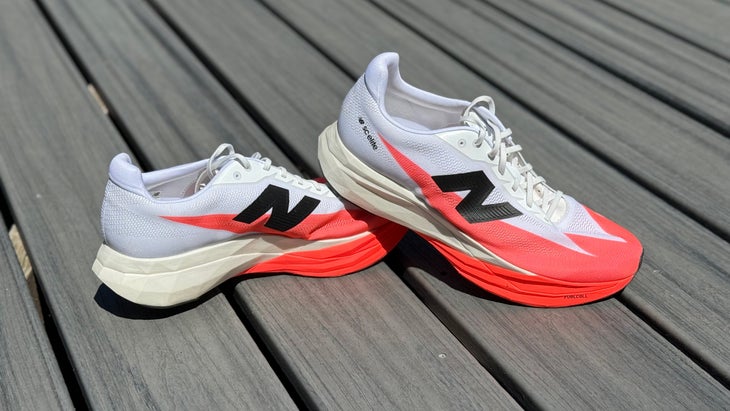
Weight: 7.6 oz (unisex)
Stack Heights: 40-32 mm / 8 mm drop
Lab Soft Score: 5 Perceived Soft Score: 7
Rocker: Average (61%) Feels: Stable stance, balanced and smooth roll
At a Glance: Blends a soft, energetic foam with a slightly more aggressive plate for a buttery smooth, stable ride with forgiving landings, most appreciated by forefoot strikers and deemed best suited for training by most testers.
Tech Details
- Nearly an ounce lighter than V4 thanks to a pared-back upper and a slimmer midsole platform
- Forefoot stack has been reduced by 2 mm, making the heel-toe drop 8 mm
- A more aggressive carbon plate is stiffer and has a tighter curve
Abby
Ride Rating: Standout
Despite winning the highly competitive award for worst name, the New Balance Fuel Cell SC Elite V5 is one of my favorite shoes in this crop. It’s more of a nostalgic throwback to the minimal racing flats of yesteryear than the maximal super shoes of today. But it fits my foot like a glove and provides a peppy, propulsive ride without being squishy. The basic laces are meh, but the gusseted tongue allows for a truly glove-like fit. Thanks to its stable platform and durable and grippy outsole, it’s highly versatile across a variety of surfaces. While most road races aren’t on dirt, a lot of my training is, which is why this shoe is a staple in my rotation. Now, if we could just do without the medieval-looking flames emanating from the toebox.
Lisa
Ride Rating: Standout
I feel the max cush, the ample, springy PEBA midsole, absorbing my impact and springing me forward…and I dig it. Despite the feeling of dropping off under the heel when standing, this shoe worked for me and my long stride; it did encourage me to land midfoot rather than on my heel, but not obnoxiously so. I also like the comfort of the upper, but find the basic, old-school laces an odd choice for such an advanced shoe.
Cory
Ride Rating: Good
I absolutely loved the v4—not for racing, but as a versatile shoe for workouts, long runs, and even easy days. It was cushioned and incredibly smooth. I still like the v5, but it’s lost a bit of the magic that made the v4 so special. It maintains that smooth ride but feels a bit firmer and sits lower to the ground. If you’re looking for a stable supershoe that feels more grounded than most, this is a solid option.
Jonathan
Ride Rating: Good
The foam feels a bit less squishy than previous versions, now falling about the middle of the pack among super shoes. Still, the emphasis here is on comfort, with a gentle compression, rebound, and rocker. I found the forefoot to be tuned nicely for a smooth and supportive stance, roll, and push-off, but the heel felt soft and wallowed a bit if I landed on it too much.
Nike Alphafly 3
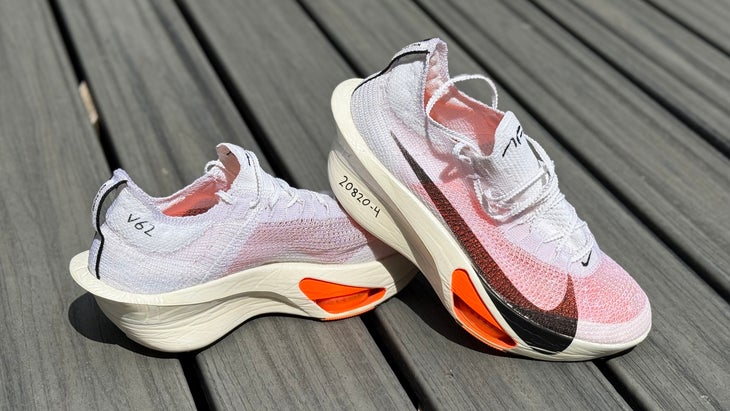
Weight: 7.6 oz (men’s); 6.1 (women’s)
Stack Heights: 40-32 mm / 8 mm drop
Lab Soft Score: 10 Perceived Soft Score: 9
Rocker: Average (59%) Feels: Starts gradually under ball, drops off steeply under toes
At a Glance: Blending the energizing bounce of responsive foam and springy compressed-air pods with a full-length, curved carbon-fiber plate, the Alphafly 3 delivers a powerful trampoline-like ride best suited for long-striding, forward-balanced marathoners.
Tech Details
- Sole redesigned with a continuous bottom, versus disjointed forefoot and heel on the previous two Alphafly models, for smoother heel-to-toe transitions
- 15 percent lighter than the Alphafly 2 and 4 percent lighter than the original Alphafly
- Both shoe shape and carbon-fiber plate wider through the midfoot, designed for better arch support and stability
- Placement of Air Zoom units adjusted to return more energy
- Soft and comfortable upper with a redesigned lacing system
Cory
Ride Rating: Standout
To me, the Alphafly 3 epitomizes the pinnacle of super shoes. With significant enhancements in weight, responsiveness, and overall performance compared to the Alphafly 2, a near-total redesign has reintroduced the trampoline-like bounce that I loved in the original. If you found the second version a bit clunky you’ll want to check these out as it combines the stability of version two with the bounce of the original. If I had to choose just one shoe for every race distance, the Alphafly 3 would undoubtedly be it.
Abby
Ride Rating: Standout
I had to size up, and I found the ride (and the slapping sound) takes a little getting used to, but after a run or two I figured out how to get this shoe to work for me—and it really feels like it’s working—like I’m being propelled underfoot. The air pods under the forefoot provide some very appreciated cush and pop, especially when I start to tire. Bonus points for the outsole being grippy enough that I feel comfortable wearing this shoe on a wide range of surfaces.
Lisa
Ride Rating: Standout
I love the looks and feel of this shoe. I have raced a 10K in it, and I look forward to every opportunity to run in it. The cushioning and plate combo make this a forgiving supershoe that works for my stride. It’s both a soft, comfortable ride and it helps me run a little faster without added effort.
Jonathan
Ride Rating: Not for Me
I loved the front half of this shoe—wide, stable, and cushioned but highly responsive, with a brilliant rocker. It starts gradually, loading up the compressed energy of the foam and Air Zoom units under the weight of my forefoot stance, then drops off abruptly so the rebound launches me forward with an effective trampoline effect. The heel, however, is a marshmallow that swallows my momentum whenever I touch down on it, which I do unless I’m practically sprinting. I might be able to adapt my stride to benefit from the bouncy forefoot, but other super shoes complement my current movement paths better.
Nike Vaporfly 4
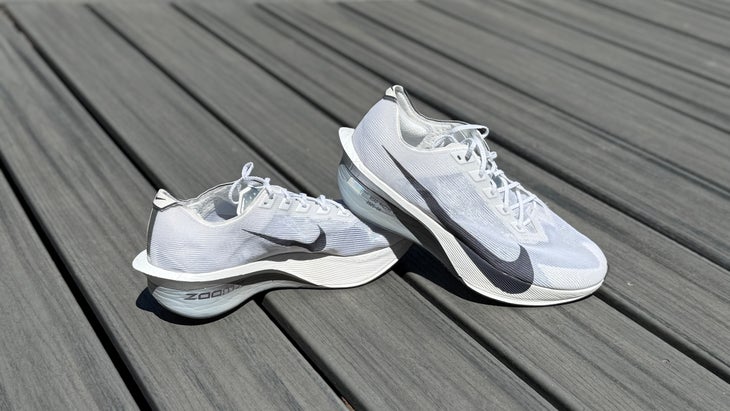
Weight: 5.9 oz (unisex)
Stack Heights: 35-29 mm / 6 mm drop
Lab Soft Score: 4 Perceived Soft Score: 5
Rocker: Early (53%) Feels: Very gradual under ball, then a late, steep roll off toes
At a Glance: A lighter, thinner Vaporfly with a foot-hugging fit and a less cushioned, more responsive, grounded ride that most testers found better geared for short distances than the marathon.
Tech Details
- Lightest Vaporfly yet thanks to reworked midsole geometry and reduced stack height
- Carbon-fiber plate made 3 degrees steeper
- Heel-to-toe drop reduced to 6 mm (down from 8 mm)
- New last with wider forefoot designed to deliver a more dialed-in fit.
Abby
Ride Rating: Standout
I’ve run a 4-mile race and a 5K in the Vaporfly 4 and didn’t think about my feet once—score. That’s partly because the shoe is so light I forgot I had anything on my feet. But also, the relatively low stack (35-29 mm) makes this shoe agile and responsive. The engineered mesh upper and lightly-padded tongue hold their shape and stay in place while allowing for a locked-in fit. I feel so fluid in this shoe—light on my toes, connected with the ground, and rolling through my stride. Put it all together, and I find it’s a very stable, poppy shoe with great grip that’s also durable enough for training.
Jonathan
Ride Rating: Good
This is my favorite Vaporfly to date, with a lower, firmer midsole that forgoes the big squish for a responsive, bouncy ride. The fit is also dialed-in, delivering one of the best full-foot holds of the bunch. The heel, however, is narrow and the arch sculpted, making it unstable when I was going slow. At faster speeds, balanced over my forefoot, the late, steep rocker and lively rebound felt propulsive and made me feel fast.
Cory
Ride Rating: Not for me
It seems to me that the Vaporfly has been struggling with its identity lately, like a teenager figuring itself out. It started as the Godsend of racing shoes (for powerful-striding speedsters), evolved into a highly cushioned racer, and now, with the v4, it’s a low-profile, less-cushioned speed shoe. Honestly, it reminds me a lot of the Streakfly, just with a plate. There’s no way I’d wear this for anything longer than a 10K. It’s not bouncy; it’s all raw responsiveness. For me, it’s just too stripped down for longer efforts.
Lisa
Ride Rating: Not for me
Oddly, the Vaporfly 4 felt firm—too firm—to me underfoot. I don’t think I have the right kind of stride for this shoe. The plate didn’t seem to engage well for me, and the firmness—especially after running in a lot of cushy supershoes—was a little odd. I also don’t love the padding “tubes” around the Achilles. (The Nike Alphafly 3 is more my speed.)
On Cloudboom Strike

Weight: 7.4 oz (men’s); 6.0 oz (women’s)
Stack Heights: 39.5-35.5 mm / 4 mm drop
Lab Soft Score: 6 Perceived Soft Score: 7
Rocker: Average (63%) Feels: Starts under ball—long, gradual, smooth roll through toe
At a Glance: With a soft underfoot feel, smooth roll, snappy toe-offs, and comfortable upper, the Cloudboom Strike delivers a bouncy, rhythmic ride best suited for long distances.
Tech Details
- Stiff, spoon-shaped and forked carbon Speedboard embedded between lower foam and the thick insert that sits directly underfoot.
- PEBA-based Helion HF hyper foam with small, strategically-placed CloudTec elements
- Longitudinal flex groove decouples the sole into two platforms, designed to aid smooth transitions and impact reduction.
- One-piece, semi-transparent mesh upper with reinforced midfoot cage and molded heel.
Cory
Ride Rating: Standout
I’m usually not a fan of On running shoes, the uppers often feel uncomfortable, and the midsoles tend to run a bit too firm for my taste. But On really hit the jackpot with this one. It strikes a great balance between cushioning and energy return, with a smooth roll and a snappy toe-off. Even though it’s one of the heavier shoes in this lineup, it still held up well at sub-marathon paces. It’s one of those shoes that tends to get overlooked among the supershoe giants, but it absolutely deserves more attention.
Abby
Ride Rating: Good
It fits my foot perfectly, complements my forefoot strike, and provides plenty of pop. I appreciate the laminated laces and padding in the tongue, which is thoughtfully stitched to the upper so it doesn’t bunch. It’s just a little unstable on turns thanks to the way the medial midsole of the insert juts out ever so slightly over the strobel board.
Jonathan
Ride Rating: Standout
My foot sinks deep into the thick slab of foam underfoot, but it doesn’t feel wobbly; the squish is contained, and the rebound seems to gather up and release under the ball of the foot for a well-timed boost. The roll is gradual until the final drop onto my toes, encouraging a long stride and push-off behind my torso. But it’s not overly prescriptive, feeling smooth with a faster cadence as well, if not quite as super.
Lisa
Ride Rating: Good
I enjoy this shoe. I like the feeling of the soft Helion Hyperfoam right underneath my foot, instead of having a flimsy sockliner covering high-quality foam. I do find the shoe to ride a tad wobbly, as I’m a full-on heel striker and perhaps the soft foam against my foot allows too much give. It is a fast, comfortable shoe that I’d wear in a race with few turns.
Puma Fast-R Nitro Elite 3
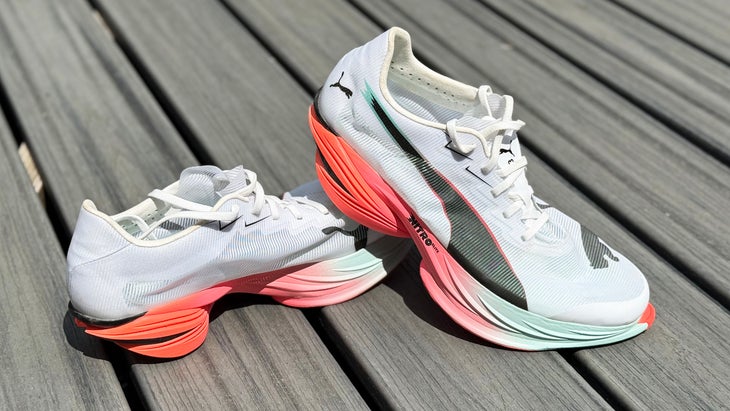
Weight: 6.0 oz (men’s); 5.2 oz (women’s)
Stack Heights: 40-32 mm / 8 mm drop
Lab Soft Score: 6 Perceived Soft Score: 6
Rocker: Early (56%) Feels: Starts early, accelerates aggressively through extended toe
At a Glance: A new, hyper-bouncy foam and refined plate give this speedy shoe an unmatched propulsive feel on push-off, but the soft, decoupled heel reduces stability at slower paces.
Tech Details
- New nitrogen-infused A-TPU foam is lighter, plusher, and springier than PEBA
- Carbon plate protrudes beyond the forefoot designed for improved propulsion and smoother transitions
- 3.4 ounces lighter than V2 thanks to thinner upper and lighter foam
Abby
Ride Rating: Standout
Fast-r indeed! I wasn’t impressed at jogging pace—the squishy heel (or lack there of) feels mushy at turtle speed. But as soon as I was up on my toes at marathon pace and faster these provided the most propulsive toe-off of any shoe I’ve worn. Like a springboard, with smooth transitions. The upper—which is so light it’s basically translucent—fits my narrow feet like a glove without squishing my toes. The paper-thin tongue is prone to crumple, but I can deal with that for shorter races. The only uninspired detail is the basic laces.
Cory
Ride Rating: Standout
I have mixed feelings about this shoe. I know it’s fast, my workouts in it are always quicker, but I hesitate to wear it for a full marathon. The decoupled forefoot and rearfoot create a unique sensation that I’m not sure I could handle over 26.2 miles. That said, I keep finding myself drawn to it. So why did I give it a “Standout” rating? Because it is fast, and isn’t that the whole point of spending big on a carbon-plated shoe? I’d definitely recommend it for more experienced runners, especially over the marathon distance. And for shorter road races, I’d be crazy not to lace these up.
Lisa
Ride Rating: Good
While the FastR NitroElite feels both fast and elite, and gave me good control and traction around tight corners, it felt a bit narrow and unstable under the heel for my heel-striking stride. I like the fit—the narrow, secure heel cup gives way to a roomier toebox perhaps better than any others in this test for me.
Jonathan
Ride Rating: Good
When I’m moving quickly, this shoe is uber fast, with the most propulsive-feeling push-off I’ve ever experienced, and a long rocker that starts rolling as soon as I weight the ball of my foot, and then accelerates off the toe. But the decoupled heel is soft, squishy, and wobbly, and makes it hard to transition to the forefoot whenever I land on my heel at all. I’ve been wearing these for speed workouts of 800m repeats or shorter, and might reach for them for a 5K if I’m feeling fit and fast.
Saucony Endorphin Elite 2
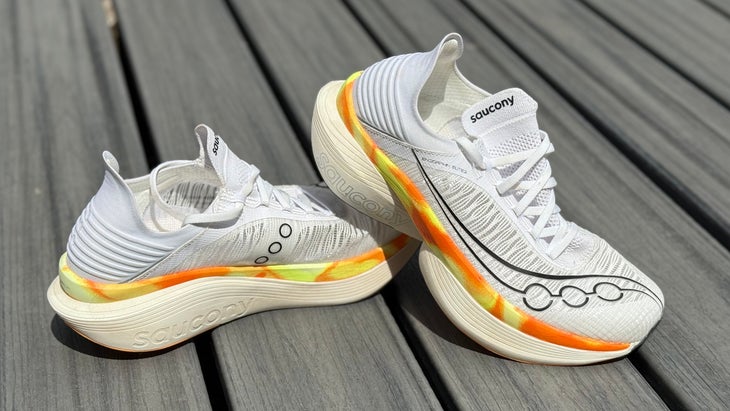
Weight: 7.0 oz (men’s); 6.4 oz (women’s)
Stack Heights: 39.5-31.5 mm / 8 mm drop
Lab Soft Score: 10 Perceived Soft Score: 10
Rocker: Late (66%) Feels: Very late with steep, aggressive slope
At a Glance: With one of the softest midsoles we’ve tested and a more flexible carbon plate, the Endorphin Elite 2 delivers a plush ride and powerful rebound for stable, fast, forefoot runners.
Tech Details
- New IncrediRUN nitrogen‑infused TPEE foam is much softer than that on the Endorphin Elite and measured one of the softest of all super shoes
- Softer rocker transition with a more flexible carbon plate.
- Lightweight knit features a stretchy bootie-like tongue
Cory
Ride Rating: Good
Saucony definitely moved in the right direction with a much softer underfoot ride compared to the original Elite. That said, I’d caution they may have gone a bit too far. This is one of the softest supershoes I’ve tested, and as a result, it feels quite unstable. I did notice it started to come together better as the pace picked up, but for most runners, especially those who liked the original Elite, this version will feel too soft.
Lisa
Ride Rating: Not for Me
I think this shoe’s plate and overall geometry are a little too aggressive for my running style. (I’m not that fast, and I heel strike.) I experienced a wonky rolling feeling from landing to toe-off, and I feel like the rocker is too drastic (for me) at the toe. This also doesn’t fit my narrow foot as well as some of the others, while running about a half-size small.
Jonathan
Ride Rating: Not for Me
With its very soft foam and late, steep rocker, I felt uncomfortable at easy to moderate paces in this updated Elite 2. On the plus side, when I’m running fast, tall and powerfully, the foam gathers under the toes and pushes back energetically at the end of my stride. But the tuning makes that happen only when I’m doing speedwork up to about 400m.
Saucony Endorphin Pro 4
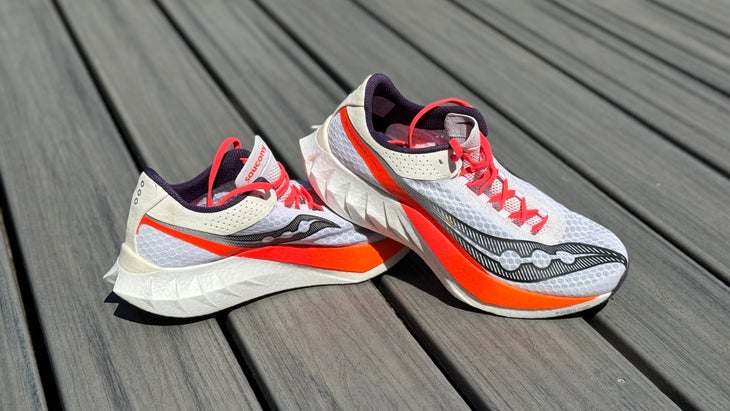
Weight: 7.5 oz (men’s); 6.5 oz (women’s)
Stack Heights: 39.5-31.5 mm / 8 mm drop
Lab Soft Score: 4 Perceived Soft Score: 6
Rocker: Average (60%) Feels: Starts under ball, rolls forward quickly, levels off under toes for a strong push-off
At a Glance: With re-engineered geometry and dual-density midsole firmness, the Endorphin Pro 4 provides a heightened sense of stability while preserving plush rearfoot cushioning, smooth heel-to-toe roll, and a lively, energetic ride.
Tech Details
- New dual-density midsole featuring PWRRUN PB (PEBA) foam on the bottom and Saucony’s new higher-rebounding PWRRUN HG (High Gradient) foam directly under the foot.
- Perforated synthetic mesh upper is better fitting, more comfortable, and more durable
- Sculpted midsole geometry is wider and more stable under the heel
- Rubber lattice outsole redesigned for better traction and reduced weight
- New supercritical-foam sockliner for better step-in comfort and cushioning
Lisa
Ride Rating: Standout
The Endorphin Pro 4 feels the most like a regular shoe—in a good way, comfortable, not crazy—than the others in this roundup, while still offering propulsive speed. I liked that I could feel the cushioning under my forefoot providing energetic pop. The fit is shallow from top to bottom, which works for me because I have a low-volume foot.
Jonathan
Ride Rating: Standout
I was pleasantly surprised by the new midsole on the Pro 4, which, to me, hits a sweet spot balancing cushioning, stability, and responsiveness while avoiding the squishy trampoline effect of earlier versions. This shoe handled my light heel strike as well as any, cushioning while not wallowing, and transitioning smoothly onto the platform and through the rockered toe. I appreciated that while the rocker rolls forward quickly at its early starting point, it seems to level off some under the toe, enabling me to reach back and push off strongly. Combining comfort, stability and performance, this shoe would be on my shortlist for a marathon or a half.
Abby
Ride Rating: Not for Me
Just looking at the pronged heel, you can tell this shoe was designed with heel strikers in mind. As a forefoot striker, I feel like I’m missing out on the plushness and propulsiveness of this shoe. Running in them, I found myself wanting to heel strike to take advantage of the softest and springiest part of the shoe—the mid and forefoot are pretty stiff and hard.
Cory
Ride Rating: Not for Me
My feelings on the new Endorphin Pro 4 were mixed. On one hand, Saucony made significant improvements to the upper. Not only did it enhance the appearance and fit, but it also proved to be much more durable compared to the Endorphin Pro 3. On the other hand, I found that the new dual-density midsole felt firmer and lacked the bounciness of its predecessor. No matter how hard I pushed it, I didn’t get the snappy trampoline sensation I felt with the Pro 3. The shoe offered a smoother running experience, leaning toward a relaxed and easygoing feel rather than a lively and energetic one—more on the cruisy side, if you will. Perfect for clocking off those midrange paces with ease, but lacking the energy return at fast paces.
Tracksmith Eliot Racer
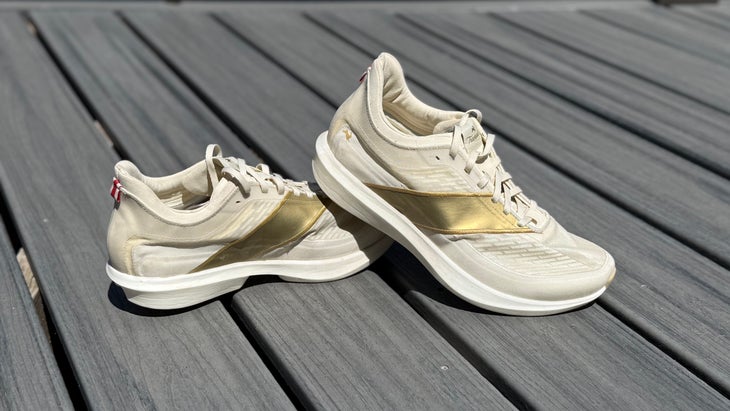
Weight: 7.7 oz (unisex)
Stack Heights: 38-30.5 mm / 7.5 mm drop
Lab Soft Score: 5 Perceived Soft Score: 7
Rocker: Early (50%) Feels: Starts at beginning of ball, long, smooth, gradual roll
At a Glance: A stable, responsive midsole that lies directly underfoot, and a long, gentle rocker combine with a wide forefoot for a smooth, accommodating ride with stripped-down styling that turns heads.
Tech Details
- Pebax midsole below the plate with removable A-TPU supercritical foam drop‑in midsole
- Engineered woven mesh upper with microsuede–lined collar and tongue
- Full length, perforated rubber sole with longitudinal flex grooves for added flexibility
Abby
Ride Rating: Standout
Sometimes, the shoe feels as pretty as it looks. The Tracksmith Eliot Racer fits my foot like a glove, with ample room in the toe box, and feels pleasantly peppy underfoot for such a sleek-looking profile. It may not be the absolute fastest shoe on this list, but it’s one of the most durable and versatile, suitable for everything from tempos to the 5K to the marathon. My only complaint is the squeak of the drop-in midsole, but I suppose that’s a refreshing change from the characteristic super shoe slap.
Jonathan
Ride Rating: Standout
I loved the firmer tuning of the foam underfoot, making the heel stable—rolling my stride forward on landing, not squishing—and delivering a nice balance of responsive cushioning and well-timed rebound under the wide forefoot. It was easy to have a quick cadence in these, and my pace was often 10–20 seconds faster than the effort suggested. I wasn’t a fan of the upper, however, as it felt stiff and buckled a bit where it flexed.
Cory
Ride Rating: Good
I really do love Tracksmith, they’ve built a loyal following, and for good reason. As expected, the designers nailed the aesthetics on the Eliot Racer: I was honestly hesitant to wear them because I didn’t want to get them dirty. The ride is cushioned, smooth, and surprisingly refined for a first supershoe. That said, it’s a bit on the heavy side for race day, and I struggled to find that effortless flow I get from some of the lighter, bouncier options on this list.
Lisa
Ride Rating: Good
The Eliot Racer is by far the most beautiful of the super shoes, IMO, its cream mesh looking oh-so-great with the gold paneling and minimal branding. I enjoy the stability in the wider forefoot of this shoe, and the soft, conforming cushioning. One beef: the laces come untied if not tightly double-knotted.
UA Velociti Elite 2
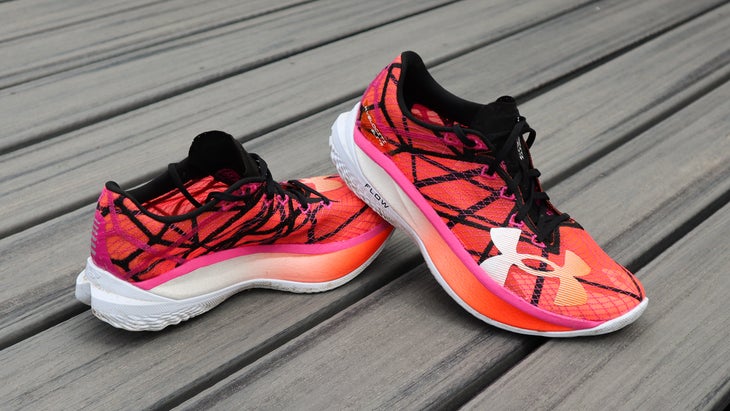
Weight: 8.2 oz (unisex)
Stack Heights: 39.5-37.5 mm / 2 mm drop
Lab Soft Score: 2 Perceived Soft Score: 4
Rocker: Average (59%) Feels: Starts gradually under ball, falls away steeply through the toe
At a Glance: A well-fitting upper, firm, stable midsole, and a smooth-rolling, aggressive rocker deliver a responsive ride that encourages a quick turnover and shines at fast paces.
Tech Details
- Stack height increased from 36–28 mm to 39.5–37.5 mm
- Heel-to-toe decreased from 8 mm to 2 mm
- New carbon fiber plate geometry has a more aggressive scoop in the forefoot
- Warp 2.0 upper is lighter and has a more anatomically contoured fit
Lisa
Ride Rating: Standout
The foam, geometry, and plate shape of Velociti Elite 2 just spells out s-m-o-o-t-h, in my opinion. This shoe feels low-to-the-ground and agile, almost like a “regular” shoe but has a whopping 39.5mm stack height under the heel that is nicely soft but springy, forgiving but responsive. That, combined with what feels like a gentle rocker and the outsole’s slightly rounded shape, seems to help me run smoothly and stay light on my feet.
Jonathan
Ride Rating: Good
I loved the fast-rolling, forward-propelling toe offs of this shoe while doing 400m and 800m repeats. I also appreciated the firmer, responsive foam and the wide base, particularly flared under the big toe, which delivered a stable, confident stance. The upper also shines, feeling like a second skin securing the whole foot without binding anywhere. At faster paces, the Velociti Elite 2 competes for the top spot on my list. The elements don’t come together quite as well at my marathon pace, however, as the rocker seems to dump me off early and force a faster turn-over and shorter stride than I want. I’ll keep it close at hand for uptempo training and short races.
Cory
Ride Rating: Not for Me
This shoe teeters on the edge of greatness but falls just short, in my opinion. Positives first: Under Armour has perfected the fit. The shoe’s Warp 2.0 upper snugly envelops and supports your foot, making it one of the best-fitting shoes I’ve ever tested. Its standout feature is an aggressively scooped firm plate that propulsively slings you forward the more power you can get through your toes. Its downfall? The cushioning, or rather, the lack thereof. This was one of the firmest super shoes I tested. I found it responsive, but not cushioned, and I unapologetically dig an uber soft, ultra bouncy foam.
Abby
Ride Rating: Not for Me
I need to size up to get the fit right. That issue aside, I found this shoe clunky and a bit dull, perhaps from the layer of EVA foam under the plate. The rocker feels a little too late-phase for my stride, and the outsole feels bulky, with horizontal ribbing that looks and feels more reminiscent of a casual shoe than a super one.
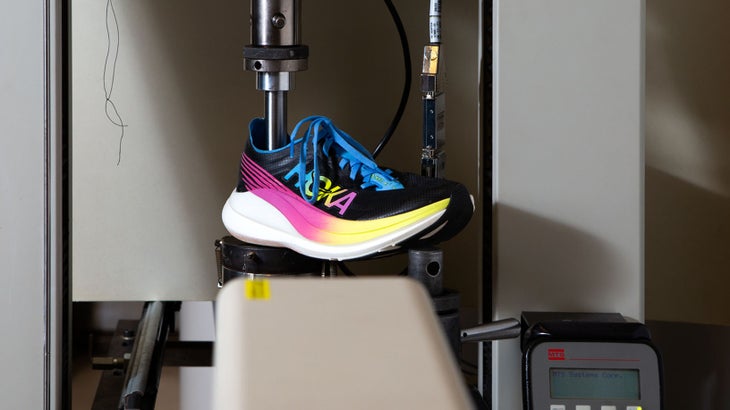
Showdown Methodology
Head-to-Head Comparison
To help you narrow your search for the right super shoe, we put dozens of miles on 19 new super shoes over the course of several months of training, including daily runs, longer outings, and a variety of speed workouts. Before completing our reviews, we also compared the shoes back-to-back, running roughly a half mile in each shoe at a progressive pace, taking notes on the ride, then changing into the next model for another loop (most of us split the showdown into more than one day this year to minimize the influence of fatigue, given the growing pile of super shoes). Throughout the testing, we paid attention to how each shoe felt on the run, which we preferred, and why. Our impressions differed, sometimes dramatically, as each of us has unique stride mechanics and shoe preferences.
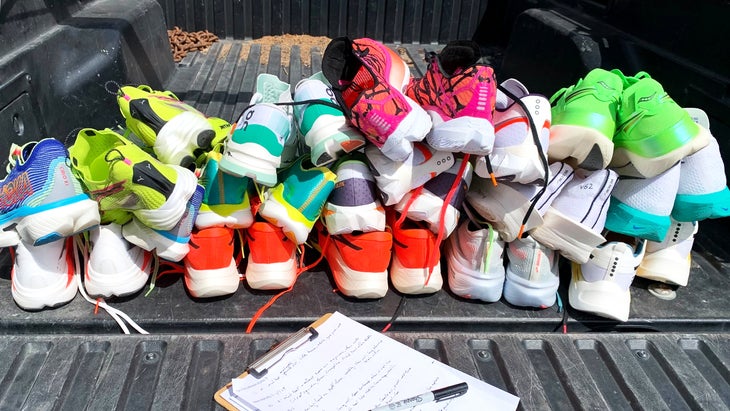
In addition to our individual reactions to each shoe, we identified two characteristics that seem to have the greatest effect on each super shoe’s ride: the squishiness of the midsole and the shape of the toe rocker. We assigned each shoe a “soft score” to rank how much we felt the foam sink in before rebounding—1 for the least deflection or firmest and 10 for the most deflection or softest—and we took the average of the testers’ scores for each shoe to arrive at a “Perceived Soft Score.” We also tested material softness in the Outside Lab (see below).
Comparing shoe to shoe, we described how each shoe’s rocker felt: where it begins along the foot, its slope and shape. The Outside Lab also measured the start location of the rockers as a percentage of the length of the shoe.
Finally, each tester gave each super shoe a personal “Ride Rating” of one of three categories, defined as:
Standout = Would wear for a race
Good = Shoe works for me, but doesn’t inspire or falls short in a minor area
Not for Me = Doesn’t work for my stride/ Detracts from my performance
How We Tested Super Shoe Midsole Softness and Rocker Location in the Outside Lab

Lab Soft Score
In the new Outside Lab @ CU Denver, we measured the foam properties by compressing each super shoe midsole 11 times under the heel to more than half their thickness (25.4mm), recording the force required to press it down throughout the compression cycle. The curve of the last (11th) compression cycle was evaluated to determine the point at which the midsole foam would stop sinking and bounce back. We considered the slope of the curve and force during the normal running compression range—while the foam sinks in and bounces back during running stride—and the late-stage curve near its maximum effective point, when the foam begins to stop compressing and is forced to return. These measurements were combined to arrive at a lab soft score that reflects how firm the sole materials are under the same loading conditions.

Most of our lab scores correspond closely to the softness felt by our field testers, but some of the testers’ ratings differ by a few points. This could reflect the dynamic properties of super foams and their integration with carbon plates. If the testers’ perceived softness was higher than the lab score, the foam likely compresses easily at first but firms up faster and stronger than other foams. If the perceived softness was lower than the lab score, the foam might have a firmer step-in feel but compresses under greater force (such as occurs when running fast).
Testers also did not isolate heel and forefoot feel, so a shoe’s difference in heel-toe drop could alter its relative position. Different plate geometries—the shape of the curve and the plate’s location in the foam between the foot and the ground—also likely affected our testers’ underfoot feel. In general, the lab score reflects the objective measurement of each foam’s properties, while the runners’ feel provides a subjective assessment of the shoe’s softness in context.

Lab Rocker Location
We measured the location of the toe rocker using a calibrated engineering ruler in combination with two square tools. The squares, metal tools machined into a fixed 90 degree angle, are used to keep the ruler end aligned with the toe and mark both the heel and rocker locations while maintaining a straight line. The total length of each shoe is measured first, from heel (the heel cup of the upper) to toe, and then the rocker start location is identified and recorded.
Rocker location is identified by the last point at which the outsole touches, which can also be seen as the pivot point when pressing down on the toe, with the shoe on a flat surface. To mark the start point we shine a light under the toe ramp to illuminate this touch of the outsole while gently pressing down on the tip of the toe to confirm the transition point.
The recorded rocker measurement location is calculated as a percentage of the total length from the heel (heel is 0%, toe is 100%) and evaluated for the stage of the stride. When considering all running shoes, “early” rocker is typically considered 60% and before, while “late” stage is greater than 70% (near 75%). All tested super shoes, however, fell into the “average” or “early” stages for standard run footwear, so we created a scale specifically for plated super shoes based on the average of our measurements.
Meet the Testers
Cory Smith
A former national-class miler with a long, powerful stride who finds the thicker and softer the super shoe, the better
Give me a hard track workout or tempo run over an easy long run any day. I love everything about racing—the anxiety, pain, victory, and defeat. My competitive spirit started over 25 years ago when I became the sixth-ranked high school 3k runner in the U.S. my senior year. Since then, I’ve been addicted to competitive running at every distance, from one mile to the marathon on the roads and trail. I was once a fan of ultra-lightweight and firm low-profile racing shoes. In the new era of super shoes, however, if there’s a plate in there, the thicker and softer the better. About half my weekly mileage is run in a super shoe. They’ve resurrected that effortless feeling of floating across the ground at high speeds from my younger and faster days, not to mention allowing me to recover faster.
Abby Levine
A college distance runner turned triathlete and ultrarunner, she’s training for an Olympic-Trials-qualifying marathon and prefers bouncy shoes that propel her forefoot-landing stride
After a decent college running career in the dark ages before super shoes (15:54 in the 5,000, 33:17 in the 10,000), I raced as a pro triathlete and then a trail/ultrarunner for much of the past decade. Now I’m back on the roads buckling down to run my first road marathon before Father Time really comes for me. My coach thinks it’s relevant to inform you that I have a “unique” running gait with a forefoot strike. And I think it’s relevant to inform you that I have a unique foot shape (narrow feet, high arches, Morton’s toe).
Lisa Jhung
A trail runner at heart who lands on her heels on roads and prefers a softer ride over firmer, but prioritizes fit and overall comfort
I generally don’t track my mileage and most often head for trails and hills, but road running in super shoes has given my road running new life. I’ve been running for about 33 years, having started on the hard packed sand of Southern California. Running in super shoes reminds me of the combination of spring and cushioning you get running fast on perfectly packed sand at low tide. (I once ran a 6-minute mile, my fastest to date, on packed sand during a race in college at U.C. Santa Barbara.) I have a connective tissue disorder which gives me loose ligaments and frequent injuries, and fallen arches when I stand but that are pronounced when I’m off my feet. That combination makes me appreciate the stability afforded by carbon plates. I sort of view super shoes as a revolutionary form of stability shoes, and I dig it.
Jonathan Beverly
An aging marathoner with a rolling stride and an iffy knee who likes a somewhat firmer, stable platform underfoot
My idea of a perfect run is 10 miles at a comfortable cruise, and has been since high school cross country in the late ’70s. I ran a marathon at age 16, and the puzzle of getting that distance right has fascinated me for most of my adult life. Once a 2:46 marathoner (pre-super shoes) regularly doing 50+ mile weeks, a series of injuries and my age (61) have reduced my volume by half and significantly slowed my easy training pace—but I still enjoy an uptempo workout or two each week. Given my need for more stability these days (and always having a preference for minimalist models), I’m not a fan of shoes with serious squish, including many of the first-gen super shoes. However, the improved stability and smoother roll in many of the newer models are winning me over to the super shoe magic. I strongly believe, however, that no one should run in super shoes all the time and that not everyone needs a super shoe to run their best.


